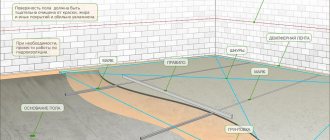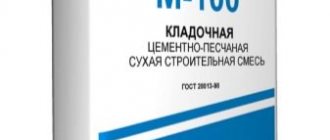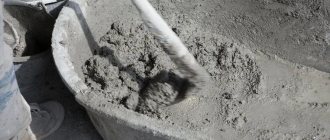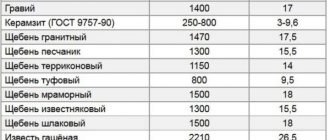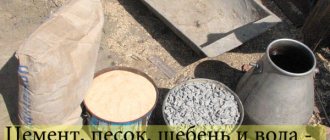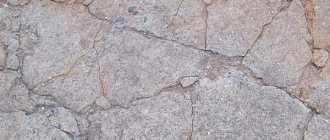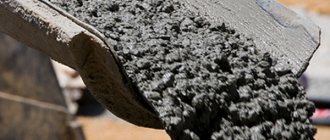Each construction of a structure must begin with the calculation of the amount of materials required for this action. Accordingly, various questions arise regarding the quantity, quality and standard proportions for the mixture. Knowing the volume of materials, it is possible to significantly save on purchasing only the necessary components. You also won’t have to travel for additional amounts of mixture, only if unplanned work arises. How to calculate the consumption of cement-sand mixture?
A mixture of cement and sand - characteristics and preparation of mortar
As a result of mixing cement and sand, a sand-cement mixture is obtained, which, when water is added, becomes suitable for use. On a large scale of construction independent preparation of the mixture is often used , although there is also a DSP specially prepared at the enterprise.
Cement sand mixture
If you purchase a factory-made DSP , then in its composition, in addition to the basic components, there are plasticizers and other additives. They are used to give the solution homogeneity and plasticity; some add frost-resistant additives for work in the cold season.
Factory mixture
Preparation of cement-sand mortar
The preparation of cement mortar greatly depends on the brand of cement and the required mortar. From this the required ratio of ingredients is calculated.
The number of components strongly depends on the purpose of the mixture, so some types of work involve a smaller amount of sand (concreting) or, conversely, a larger amount (masonry).
For more flexible preparation of the solution, sand and cement should be mixed manually; the standard ratio is 1 to 3, but it can be 1 to 2-4. The mixtures are also different; a huge range covers most ordinary needs.
To avoid unnecessary costs for materials that are not useful in construction, you should make a calculation. It will help you more accurately determine the required amount of mixture.
But it is not always possible to achieve an exact value due to the lack of information about the density of the material, because it may differ.
The purpose of cement plays an important role when choosing a brand:
- m100 is used only for plastering walls, approximate consumption 550-570 kg/m3;
- m150 is usually used for bricklaying, cinder block or installation; in rare cases, for concreting, the consumption is 570-590 kg/m3;
- m200 masonry and installation mixture must be prepared 590-620 kg/m3;
- m300 is used for concreting and pouring areas that bear increased load, consumption 620-660 kg/m3;
- m400 for especially strong concrete structures, consumption ranges from 660-710 kg/m3.
When calculating the required materials per 1 m3, it is possible to quite accurately determine the brand and quantity of PCB . They are also interchangeable, if the use of M150 is recommended, the cement can be replaced with M200 and M100 without much damage to the calculations and strength of the structure.
When UPS is applied: layer height
Having figured out how to calculate how many components are needed, it is necessary to explain the reasons for the different layer heights. The latter directly depends on the purpose of the preparatory layer:
- Link element. Necessary for fastening the rough base and walls. Up to 4 cm.
- Separate element. Serves as a base for flooring. Up to 5 cm.
- Floating slab. If the area of the mixture is separated from the walls and floor by another layer. From 5 cm to 7 cm.
Screed for heated floors Height affects the weight of the covering.
Therefore, it is important to soberly assess the capabilities and necessary characteristics of the foundation. If you can't align them, look for alternative alignment methods. For cement-sand screed, there is a list of situations in which use is justified:
- use of water or electric heated floors;
- the presence of only a subfloor;
- the need to create drainage and water drainage systems;
- strong relief of the coating.
How many materials will be needed - consumption per 1 m2, 1 m3
The amount of cement-sand mixture is calculated based on the cubic capacity of the room or site. You can easily calculate the footage using a regular tape measure, and then multiply the length by the width to get the area of the space that needs to be filled with cement.
The key parameter is the layer depth. Depth is a necessary indicator, as it directly affects consumption. On average, if the layer thickness is 10 mm, then 22 kg per m2 is required. For a 10 cm screed, 50 kg of M400 mixture is required.
To individually calculate the amount of mixture, you need to use the indicator 1 m3, this way you can calculate the volume of the solution. Here are some approximate calculations using a calculator to determine the amount of materials in construction.
Consumption of materials
If the area of the room is 100 m2, and the depth of the layer is 10 cm (must be converted to m), then it will be: 100 * 0.1 = 10 m3.
Very roughly, but per 1 m3 on average there are 555 - 713 kg of mixture; more accurate data should be contained on the packaging. If you mixed it by hand, you need to approximately calculate the required weight. The rule is that the higher the grade of the solution, the greater its weight.
M400 cement is characterized by a maximum weight of 700 kg per m3. As the grade decreases, the weight also decreases. M100 weighs approximately 550-600 kg per 1 m3.
This pattern is true for both manual and starting mixtures. The amount of dry mixture does not reflect its volume as a solution; 1 liter contains about 1.4 kg of dry mixture. Thus, if it is necessary to fill 10 m3, then the further calculation will be (using the example of M300):
(10 m3 * 650 kg)*1.4 = 9100 kg
Thus, to fill 10 m3 you will need a mixture in the amount of 6500 liters or 9100 kg of dry mixture .
Brands of sand concrete used and their composition
The material classification includes all mixtures of this type that are not even used in screeding operations. Their scope of application depends on the strength of the solution, indicated by the letter “M” and numbers. The larger the latter, the better the characteristic. Today, according to new standards, the marking has changed, but many craftsmen use the old one.
- This mixture is used for plastering work. Its old marking is M100, the new one is B7.5 P2 F200 W4. In addition to Portland cement, the composition includes river sand of a fraction of 0.8-1.2 mm. This type of sand concrete has good strength - 98-100 kg/cm². A waterproof class W
- Brand M150 – new B710 P2 F200 W4. It is used for plastering work and for repairing facades. Some craftsmen use this dry mixture as masonry mortar, where it has performed well. Sometimes you can use it to fill floors that are classified as lightly loaded. The composition includes both river and quartz sand of fraction 0.8-2.0 mm. Compressive strength 150-161 kg/cm². The material is classified as lightweight concrete, so it can be pumped to a height of 52 m using a concrete pump.
- M200 or B15 P2 F200 W4. It is recommended to use it when pouring screeds in interior spaces. And also when covering the heating system with a warm floor. It contains both quartz and fine river sand. Compressive strength characteristics: 196-200 kg/cm².
- M250 or B20 P2 F200 W4. This is one of the most durable mixtures with a characteristic of 250-262 kg/cm². Therefore, this material is used to form floors and create fences for different purposes. And also in the construction of monolithic load-bearing structures.
- M300, in a new way B25 P2 F200 W4. This variety is considered universal. That is, it can be used to pour screeds, floors, columns and other load-bearing elements of buildings. And also used in plastering works, especially facades. The practice of using sand concrete of this brand in monolithic construction has justified itself from all sides.
- M450 – V35 P2 F200 W4. This mixture is practically not used in private housing construction. This pleasure is too expensive. But in civil and industrial applications they are constantly used.
Based on the composition and quality of sand, the material is divided into two groups:
- Fine-grained, in which the largest particle size does not exceed 1.2 mm.
- Large fractional. The sand granules in it measure up to 6 mm.
Attention! The higher the fractionation of sand concrete, the higher its grade.
Calculation of DSP for plaster
The quantity and cubic capacity of consumables for plastering a wall is quite difficult to determine. The reason is that the walls are rarely even, they usually have protrusions, recesses, and the layer in each area is slightly different.
It is necessary to determine the average depth of the layer in order to calculate the volume of the cement-sand mixture . For example, per 5 mm layer there is 7 kg of mixture per 1 m2.
Calculation for plaster
The thickness of the plaster ranges from 5 to 30 mm . When plastering, it is worth considering the number of additional components; slaked lime is often added.
For large volumes of work, a batch is made consisting of:
- 4 bags of cement;
- 40 kg of slaked lime;
- 550 kg of sand;
- 100 liters of water.
So many ingredients comply with regulatory rules per 1 m3.
When plastering, the standard proportion of cement with sand is 1 to 3. If the layer thickness does not exceed 12 mm, then 1 m2 of plaster will pull approximately 1.6 kg of M400 mixture; if you use M500, the amount will drop to 1.4 kg.
Plasticizers, liquid soap and the like should not be taken into account, since their proportional ratio is insignificant. It is not recommended to make large batches at once, since the solution may harden if it is not possible to spread it within 1-1.5 hours.
Table 1. Weight of dry concrete of different brands
| Brand | Mass of a cube of dry concrete, t |
| M100 | 2,18 |
| M150 | 2,181 |
| M200 | 2,182 |
| M300 | 2,183 |
| M400 | 2,17 |
| M500 | 2,18 |
The given data corresponds to the standards prescribed in GOST 23464-79. They can be achieved by observing the recommended ratio of components, mixing method and curing conditions. But ideal conditions are unattainable in practice, so results may vary significantly.
Number of PCB bags for brickwork and calculations on a calculator
Laying a brick wall should be done using a mixture with a grade corresponding to the brick. This structure is as durable and uniform as possible. In general, M100-M200 is used for masonry.
So it is necessary to take into account the quality and strength of the material (both the mixture and the brick). Using basic standards, approximately 250 kg of M100 mixture should be used per 1 m3 of wall.
Cement is the main and main component for most buildings and structures. Here's how to properly dilute cement.
The use of sand is a necessary measure when carrying out any construction or repair work. Here everything is about quartz sand.
Kitchen renovation is a very important and serious matter and must be approached with all responsibility. By clicking on the link, you will get acquainted with wall panels for the kitchen made of plastic with photo printing.
If you prepare the solution yourself, then the proportion should be 1 to 4. Liquid should be added to the CPS, which is usually half the total weight of the mixture.
Of course, the laying of a wall greatly depends on the thickness of the seams; as the space between the bricks expands, the amount of mortar per 1 m3 also increases. The thickness of the walls also plays an important role, so for facing bricks laid in 1 layer, significantly less cement is required than for load-bearing walls of 2-4 bricks.
Calculation for masonry
Regulatory documents contain detailed recommendations and the relationship between wall thickness and the amount of mortar used.
Examples are presented based on ordinary bricks and the required quantity per 1 m3:
- wall 12cm - 420 bricks and 0.19 m3 of mortar;
- wall 25cm – 400 bricks and 0.22 m3 of mortar;
- wall 38cm – 395 bricks and 0.234 m3 of mortar;
- wall 51cm – 394 bricks and 0.24 m3 of mortar;
- wall 64cm - 392 bricks and 0.245 m3 of mortar.
Calculation of sand-cement dry mixture for screed
The screed is characterized by the presence of increased pressure on the finished site. This characterizes the increased need for screed strength. Therefore, a mixture of M300 or M400 should be used. In some cases, M200 is also used, but only where high strength is not required.
The main nuance when screeding is its depth; the deeper it is, the more mortar will be needed per 1 m2. In general, the screed rarely exceeds 30 cm; an additional layer of crushed stone or gravel is laid below to create a platform.
It is necessary to calculate the number of DSPs after forming a platform from bulk materials, if one is planned.
The required amount of materials can be calculated based on the parameter 1 m3. The area and depth must first be converted into this value. A room with an area of 50 m2 and a screed depth of 20 cm will require 50 m2 * 0.2 m = 10 m3.
Calculation for screed
Next, by selecting the grade of mixture required for the task, usually M200 or M300, you can determine the amount of material to be purchased. In addition to the brand, the weight per 1 m3 also depends on the manufacturer and the components that were used.
For M200 per 10 m3, it is necessary to use a flow rate of about 600 kg/m3 * 10 m3 = 6000 kg, while taking into account a draft of 1 to 1.4. That is, you should acquire 8400 kg of mixture for 10 m3 of screed.
For M300 the volume is slightly different: 650 kg/m3 * 10 m3 = 6500 kg. Taking into account some settling when preparing the mixture, the volume becomes approximately 9100 m3.
Regardless of the preparation method (manual or ready-made DSP), such a calculation will help to roughly navigate the amount of materials. But when producing the mixture manually, it is necessary to accurately determine the brand of the solution.
For more information on calculating screed materials, watch the video:
Products in category
Quick-hardening self-leveling floor Osnovit SKORLINE T-45, 20 kg
319.99 rub.
| Quick-hardening self-leveling floor Osnovit SKORLINE T-45, 20 kg 319.99 rub. | Quick-hardening self-leveling floor Osnovit SKORLINE T-45, 20 kg 319.99 rub. | Quick-hardening self-leveling floor Osnovit SKORLINE T-45, 20 kg 319.99 rub. | Quick-hardening self-leveling floor Osnovit SKORLINE T-45, 20 kg 319.99 rub. |
Additional recommendations
It should be borne in mind that each individual mixture may contain a different number of components and their ratio or quality. Thus, it is quite difficult to accurately determine the weight; only approximately take as a basis the average statistical data based on the brand of the mixture.
Not only the amount of sand matters, but also its fraction. Fine-grained sand is heavier than coarse sand. An increase in voids, with a large fraction, leads to a lighter weight of the entire solution. It is generally impossible to calculate a solution prepared by yourself, since each batch will be slightly different from the previous one.
In general, the brand of composition may vary slightly from the recommended parameters, but in this case a larger amount of solution will be used per 1 m2, which will somewhat compensate for the decrease in strength.
Similarly, with a larger brand, less mixture will be needed per 1 m2. So, when filling the site, you can use other brands instead of M300, both M200 and M400, the results will differ slightly.
The freshness of the cement plays an important role . If the cement was produced more than 1 month ago, then its characteristics are slightly reduced, by approximately 10-15%. Thus, a little more cement is added to the solution.
Drying the solution from the moment of preparation takes about 1-1.5 hours. Subsequently, it ceases to be suitable and begins to form into a single whole. Even adding water will not restore the proper elasticity of the mixture.
